Popayán is a colonial gem in Colombia best known for its white buildings and beautiful churches. It’s a city off the beaten path for foreign tourists to Colombia but Popayán is definitely worth visiting.
Popayán is the capital of the Cauca department in Colombia. The city’s historic downtown is considered one of the most beautiful and best preserved Colonial centers in Colombia and Latin America. Also, the city has a strong religious presence with many churches and traditions like Semana Santa (Holy Week), a gastronomy recognized by UNESCO and hiking at the nearby Parque Nacional Natural Puracé.
All these ingredients, make Popayán a recommended destination during your trip to Colombia. Find out what are the best things to see and do in Popayán.
18 Top Things to See and Do in Popayán
Based on my recent trip to the city, I recommend the following list of 18 top things to see and do in Popayán. Also, note that these things to see and do are in no particular order.
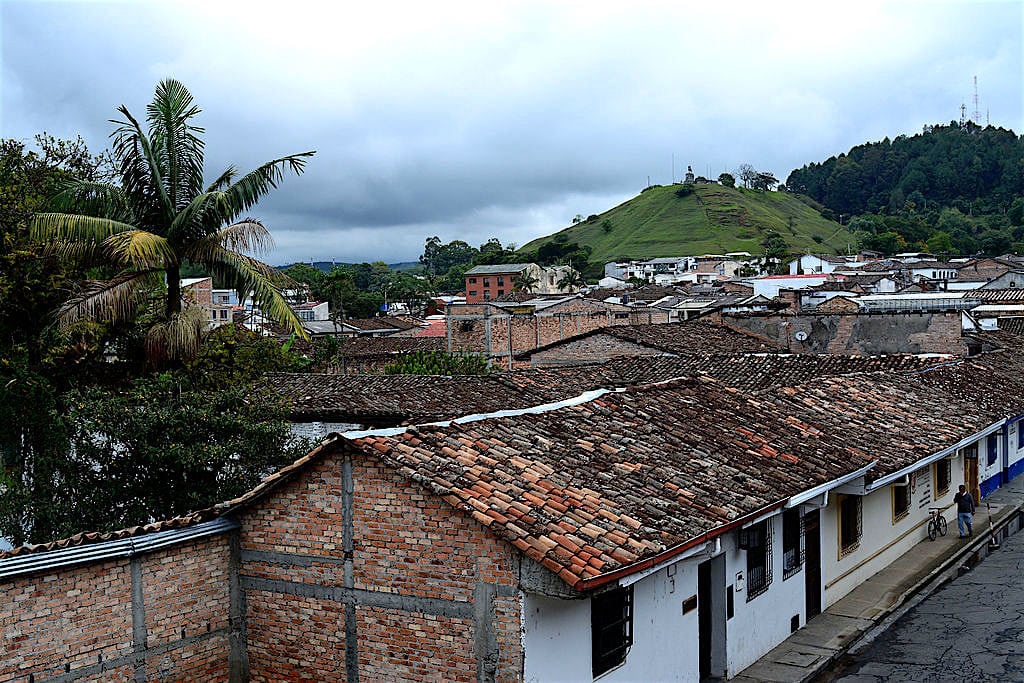
El Morro de Tulcán, photo by Julian David Muñoz Ortega
1. Visit El Morro de Tulcán
El Morro de Tulcán is an artificial pyramid that was constructed by indigenous people during the pre-Columbian era (1600-500 BC). At the time, it even stood higher than today. The Spaniards decided to cut the pyramid down when they arrived in the city in 1535.
Before arrival of the Spanish, the indigenous saw this site as a magnetic center, a sacred place, where they held rituals and prayers. Today, a statue of the founder of the city of Popayán, Sebastián de Belalcázar is located at the top.

Panoramic view of Popayán from El Morro de Tulcán
This is the main archaeological site in Popayán. And we recommend visiting during the sunset hours. From this height you have an unmatchable view of the entire city of Popayán. In addition, you can more easily climb it from the back of the pyramid. And if you are more adventurous, from the front, like some “loco locals” do!

White building along the streets of Popayán
2. Wander the White Streets of Popayán
Popayán is known as the “white city” or La Ciudad Blanca due to the color of the most of colonial buildings in the city center. Also, it’s very distinctive to others cities in Colombia and the world, with its whitewashed walls throughout.
Why white? A long time ago, an insect, the nigua infected the inhabitants of Popayàn, with the tungiasis skin disease. And this caused severe problems with the population who walked barefoot. But it was discovered that white chalk was the most efficient way to kill this insect. Here are three additional photos taken along the streets of Popayán:

Streets of Popayán

Façade of a typical house in Popayán in Black and White

Façade of a house in Popayan
Today, the city is painted in white and it’s even mandatory for the Centro Historico in the city to be re-painted once every year. In most parts of the city, the architecture was preserved from the colonial era, a true heritage on display.

Parque Caldas in Popayán, Colombia
3. See Parque Caldas
Parque Caldas is considered the heart of the city of Popayán. It was created in 1537, along with the foundation of the city.
This tree-lined square in El Centro Historico is surrounded by City Hall and the Governor’s Palace and other important buildings.
The park’s main feature is a statue of Colombian revolutionary hero Francisco Jose de Caldas. Throughout the park you’ll see vendors surround selling candy, cigarettes, juice and many other products. And there are several nearby restaurants.
El Centro Historico in Popayán where Parque Caldas is located is considered one of the most beautiful and best-preserved city centers in Colombia.

Inside the Semana Santa museum in Popayán
4. Experience Holy Week in Popayán or Visit the Semana Santa Museum
Every year in April, Popayán celebrates the Holy Week, which is known as Semana Santa in Spanish.
The processions celebrate the passion and death of Jesus Christ through parades. It is one of the oldest traditions in Colombia, practices since the Colonial period. Ancient religious images are paraded through Popayán’s historical downtown streets. And they are borne on wooden platforms.

Semana Santa in Popayán, Colombia, photo by National Police of Colombia

Photographs of Semana Santa celebrations
In addition, since 2009, Popayán’s Semana Santa processions were added to UNESCO’s Intangible Cultural Heritage Lists.
Also, during Holy Week, Popayán is home to the Festival de Música Religiosa.
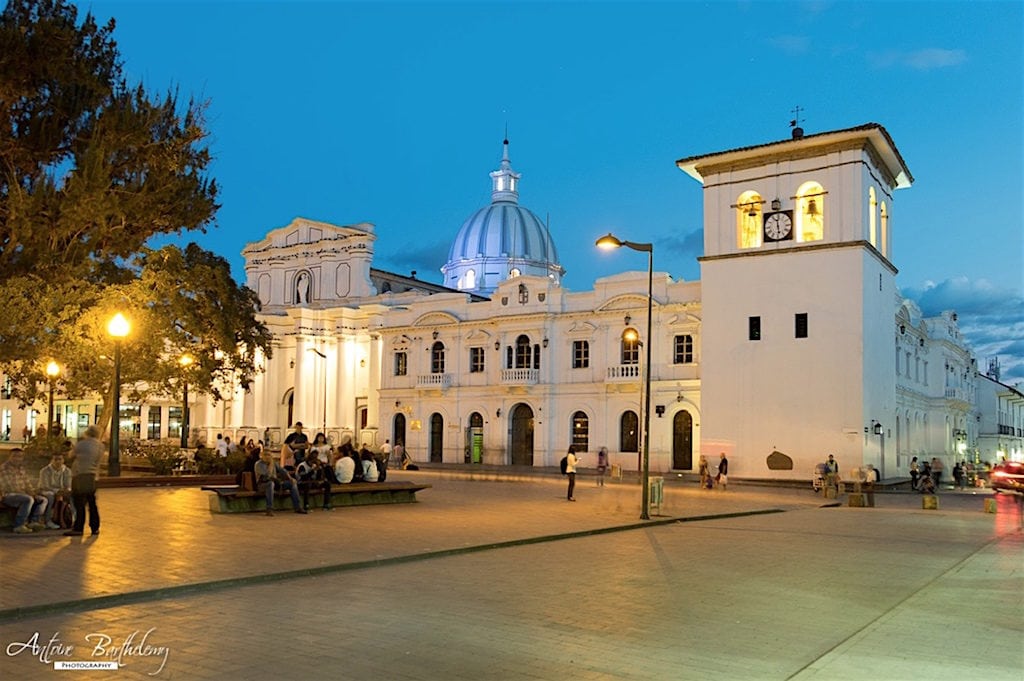
Catedral Basílica Nuestra Señora de la Asunción at night
5. Visit Catedral Basílica Nuestra Señora de la Asunción
Popayán is known for being a religious city and it’s a common destination for pilgrimage journeys with 30 churches in the city.
Catedral Basílica Nuestra Señora de la Asunción is also known as “La Catedral” by the inhabitants of Popayàn. The church is located at the south side of the main square of Popayán, Parque Caldas.
The church was originally constructed in 1558. But it had to be rebuilt after the earthquakes of 1736 and 1983.
In the earthquake in 1983, the inhabitants of Popayàn thought it would be safe in the church. And many of them sought refuge under the dome. Unfortunately, the earthquake of magnitude 5.5 on the Richter scale was too strong for the dome to sustain, and it collapsed. About 25 percent of the reported 267 who died in that earthquake, happened in La Cathedral.
It is nonetheless a beautiful religious monument, with a neoclassical architecture and French interior. Here are three more photos of this beautiful church.

La Catedral view from the sky “Droneview”

Dome of La Catedral
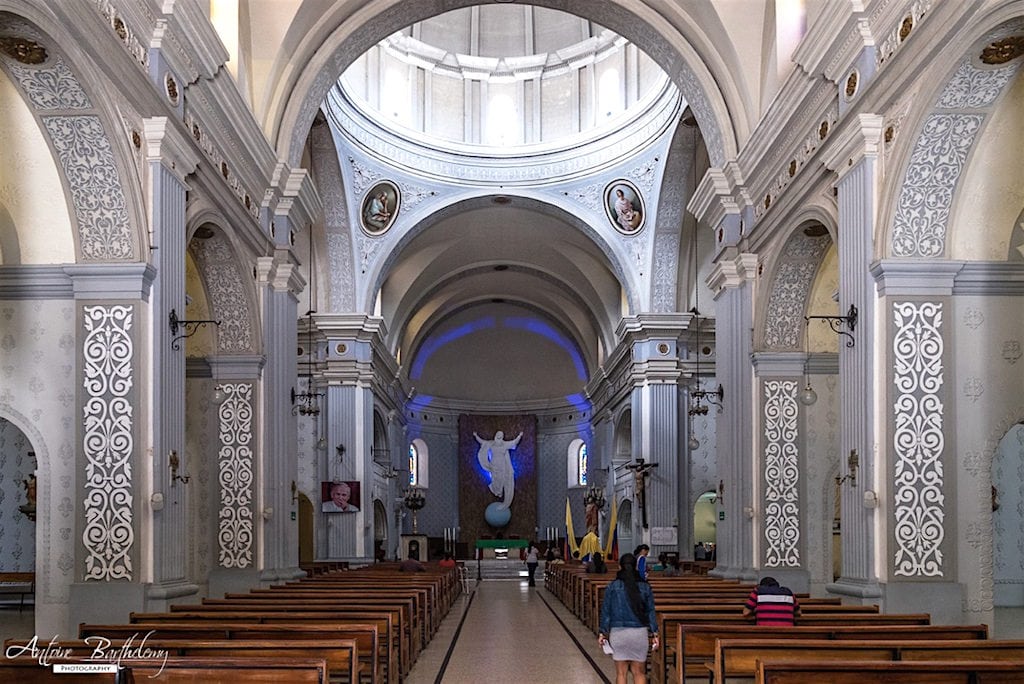
Inside of La Catedral
In addition,Catedral Basílica Nuestra Señora de la Asunción is considered the main church of the city among a total of 30 churches in the small city. Also, it’s the seat of the Archbishop.
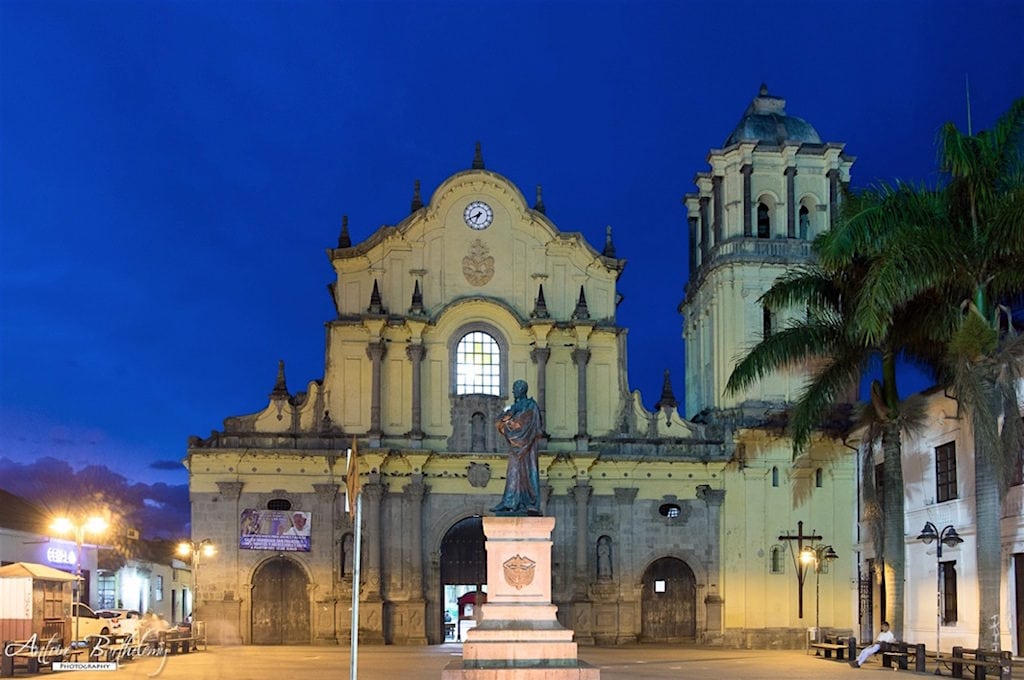
Iglesia San Francisco
6. Visit Iglesia San Francisco
Iglesia San Francisco is considered one of the most important churches of Colombia due to its neogranadine, late baroque architecture.
It also has one of the largest bells in America, called Campana de San Antonio, cast in gold and bronze. Another impressive fixture, the plateresque, which is a form of art, especially in architecture, developed in Spain at the end of the 15th century.

Inside Iglesia San Francisco
The church was originally built in the 16th century but was destroyed by the earthquake of 1736. A replacement church reportedly started construction in 1765 but some historians believe it was 1775 and other documents indicate it was started in 1771. The church was designed by the Spanish architect Antonio García.
Iglesia San Francisco is the richest and largest in Popayán. And it has the largest collection of religious art out of all the churches in the city. It was declared a national monument in 1996 and from this church Santa Semana starts in Popayán on Holy Thursday.

La Ermita de Jesús Nazareno
7. Visit La Ermita de Jesús Nazareno
La Ermita de Jesús Nazareno is the oldest church in Popayán, dating from 1546. And it’s dedicated to the first Patron of the city, Jesus Nazareno.
It was the main temple of the city until the construction of the Catedral Basilica Nuestra Señora de la Asunción.
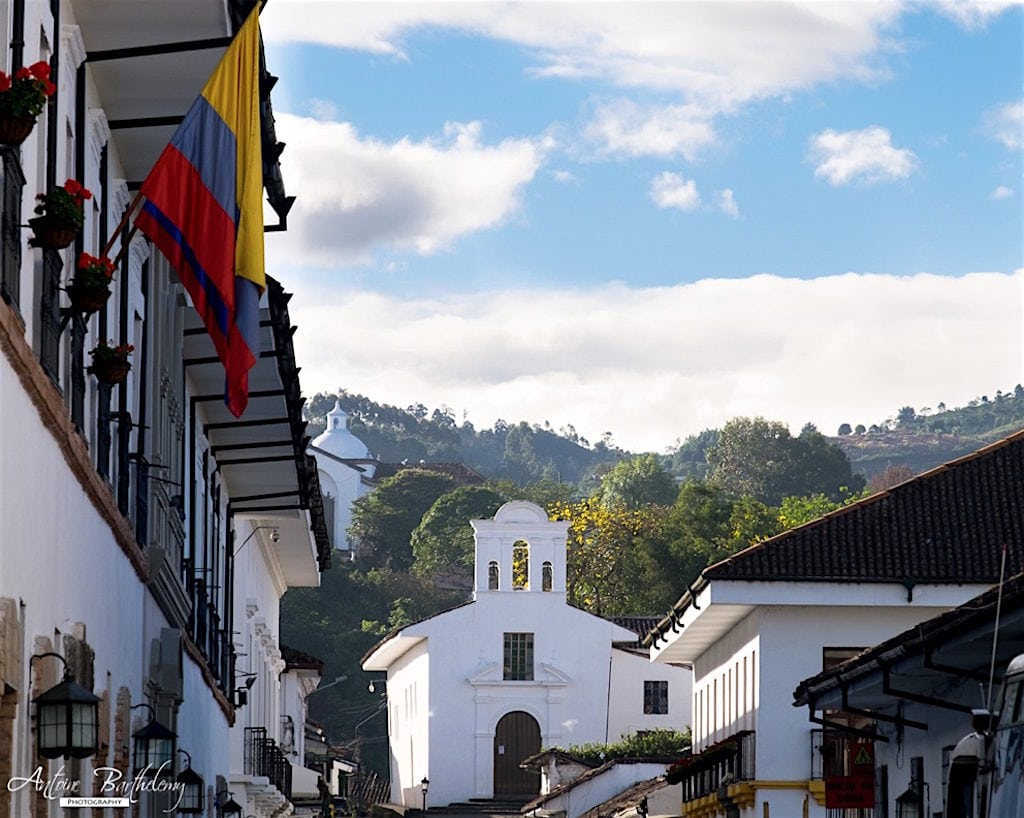
View of La Ermita from the streets of Popayán
The calvary is admirable with a Spanish image of the crucified Lord. At the top of the altarpiece, appears a crowned double-headed eagle.
This church walls and roof were damaged in the earthquake of March 1983. So, major repair work was required to restore the church.

Iglesia de San José
8. Visit Iglesia de San José
Iglesia de San José was constructed in 1707. But then it was completely destroyed in the earthquake of 1736.
It is the community of the Jesuits who constructed this temple and it belonged to them until they were expelled from the city, in 1767.
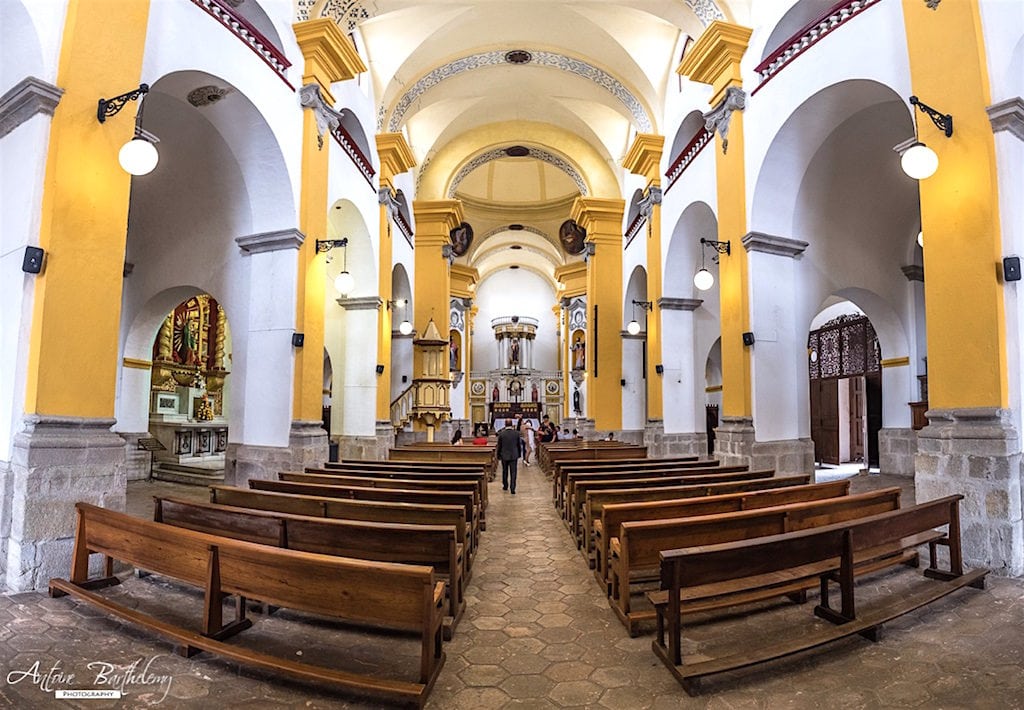
Inside Iglesia de San José
In addition, the Popayán earthquake in March 1983 caused very serious damage to the church requiring much repair work
This beautiful church is of Ionic style with tendencies to the Baroque and the Herrerian architecture. It functions today as a chapel. And in 1996, it was declared a national monument.
Note that all the four churches I visited in Popayán and recommend in this article, are located on the same street, “the church street”, which is adjacent to Parque Caldas.

Torre del Roloj
9. Visit La Torre del Roloj
Torre del Reloj (Clock Tower) is one of the oldest monuments still standing today in the city. It was originally constructed between 1673 and 1682 with 96,000 bricks. And it’s considered an emblem of the city.
The great poet Guillermo Valencia called it “The nose of the city” because it was the highest building at the time.
The tower miraculously survived the earthquake of 1736 but unfortunately was damaged during the earthquake in 1983. It stands next to Catedral Basílica Nuestra Señora de la Asunción
10. Go on a “Free” Walking Tour of Popayán
Every day at 10 am or 2 pm, a two-hour free walking tour is organized by the NGO Get Up and Go Colombia.
I personally learned invaluable information from this tour, including information I didn’t see online. Also, Popayán is a flat and relatively small city. So, it’s very walkable.
The tour goes to the major sites of Popayán, including the Cathedral, University del Cauca and Puente del Humilladero. The tour departs from the Tourism office in Parque Caldas. And a tip is appreciated at the end of the tour.
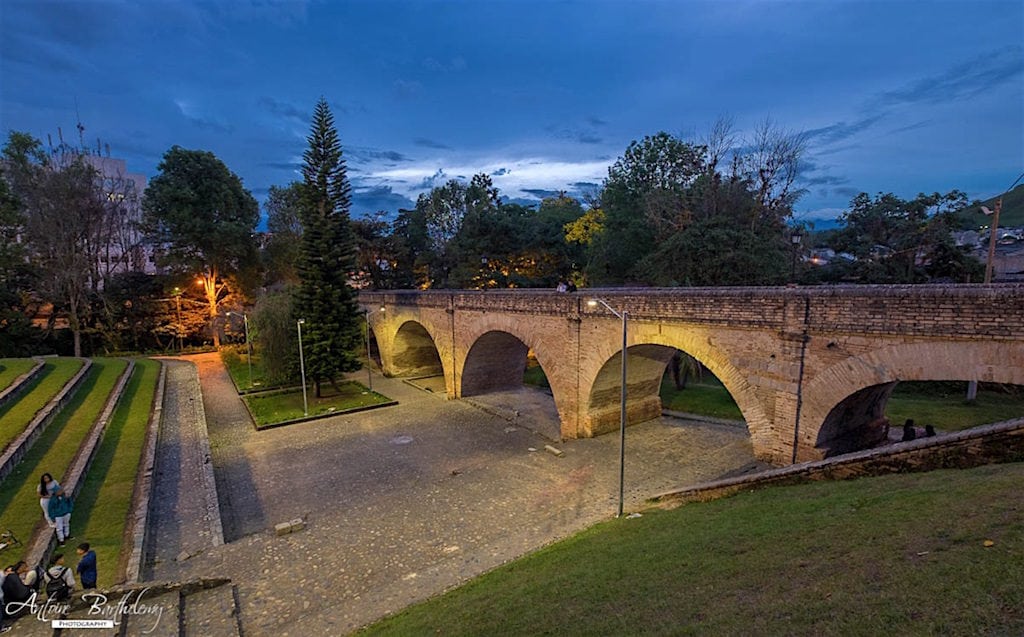
Puente del Humilladero
11. Visit Puente del Humilladero
Puente del Humilladero (Humilladero Bridge), which was built over the Molino river, was once the main entrance to the city of Popayán. It’s located near the main square in Popayán.
The bridge was constructed in 1873 by an Italian architect, Fray Serafín Barbetti, who also contributed to the work of the Basilica Cathedral of Our Lady of the Assumption in Popayán.
The bridge was built between the center of the city and the northern El Callejón neighborhood (today the Bolívar neighborhood). Before the construction of the bridge this route was steep and difficult to climb with heavy loads.
The bridge is located near Museo Guillermo Leon De Valencia. Be careful not to walk further than the bridge, as the area beyond is generally considered not very safe.

Universidad del Cauca in Popayán where Museo de la Historia National is located
12. Visit Museo de la Historia Nacional
Museo de la Historia National at the Universidad del Cauca in Popayán is reputed to be the best National Historic Museum in Colombia, even though, there isn’t much concurrence!
The museum contains many exhibits including semi-precious stones, birds, insects, indigenous pottery and pre-Columbian statues. There is even a moose and a polar bear.
The staff in the museum are students that can answer questions. The museum is open Monday to Sunday from 9 am to noon and 2 pm to 5pm. The entrance fee is only 3,000 pesos and 2,000 pesos for children under 12-years-old.
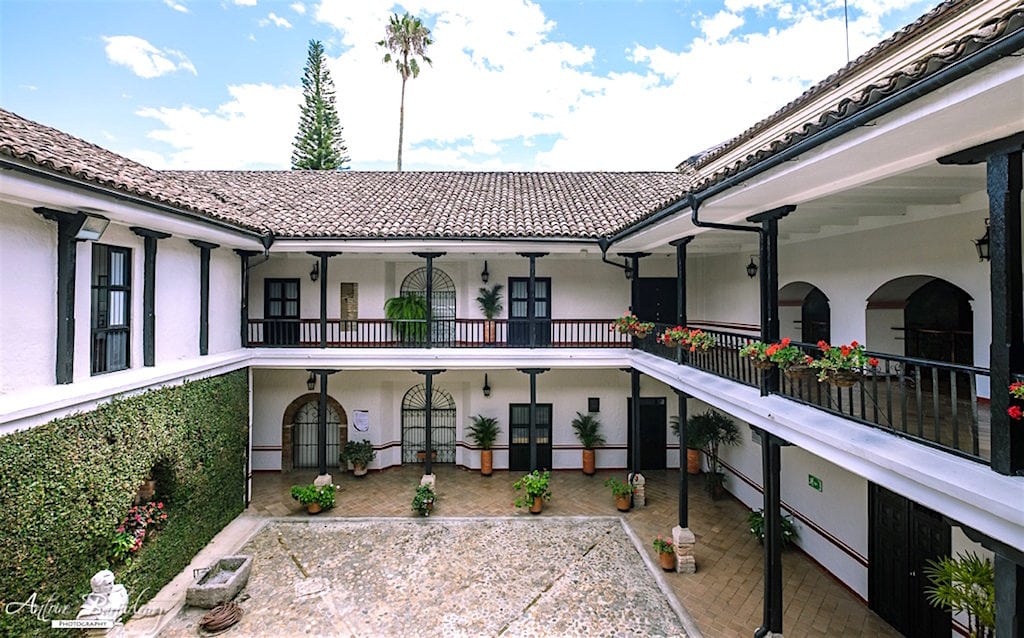
Universidad del Cauca
13. Visit Universidad del Cauca
Popayán has proved to be a breeding ground for intellectuals. It was home to 17 previous Colombia presidents, as well as noted poets, painters and composers.
Popayán is also the birthplace of José Hilario López, who declared the abolition of slavery in Colombia in 1851, which was 11 years before of United States.
The Universidad del Cauca in Popayán is a prestigious university that is one of the oldest universities in Colombia. It was established in 1827 by Simόn Bolίvar and Francisco de Paula Santander, the main leaders of independence of Colombia.
The university today welcome students from all over Colombia and beyond. So, it’s common to meet Mexicans or even Europeans who study at the University. The University offers 43 undergraduate and 48 graduate programs through various colleges.
In addition, Popayán is considered a university city and the students give the city a vibrant feel.
14. Visit the Museo Arquidiocesano de Arte Religioso
Museo Arquidiocesano de Arte Religioso is a popular religious art museum in Popayán.
You don’t have to be an expert in religious art to be impressed by the collection of paints, statues, silverware, ceramics and liturgical vases found in this museum.
Most of the items on display date back to the period between the 14th and 18th centuries.

Waterfall in Parque Nacional Natural Puracé, photo by Diego Acosta
15. Hike in Parque Nacional Natural Puracé
A hike in Parque Nacional Natural Puracé is probably ranked as one of the best one-day things to do while in Popayán. The park was declared a Biosphere Reserve in 1979 by UNESCO.
Within this park is the volcanic chain known as Serranía de los Coconucos, composed of 11 volcanos. Of these the most outstanding are Pan de Azúcar (16,400 feet – 5,000 meters above sea level), Puracé (15,682 feet – 4,780 meters above sea level), which is the only active volcano, and Coconuco (15,092 feet – 4,600 meters above sea level)
Hiking to a volcano recommends a good level of fitness and a guide. It is recommended to go between July and August, for a more welcoming weather. Or you can choose to go on a 9 mile (15 km) trail in the park.
Buses leave Popayán to the park at 5 am, 6:30 am, 10:30 am, 1 pm and 2:30 pm with two different companies. And check with your hostel/hotel the exact location of the departure. The journey will take about an hour and thirty minutes and you should be dropped off at Terminales de San Juan. And make sure you inform the driver. Also, the park is sometimes closed.

Coconuco Thermal Springs, photo by John Galindo
16. Go to the Coconuco Thermal Springs
Another day trip you can do from Popayán is a visit the Coconuco thermal springs to relax and enjoy nature. The pueblo of Coconuco is located about 19 miles (30 km) from Popayán and buses depart about hourly.
There are two thermal springs options in Coconuco: Aguas Tibias and Agua Hirviendo.
Aguas Tibias is privately owned. They have some nice paths from pool to pool and it’s very well maintained. Also, there is a waterslide, mud pool, restaurant and you can rent horses.
Agua Hirviendo in Coconuco has hotter water and the pools are closer to each other. During the weekend this place can get very busy as it’s a bit cheaper than Aguas Tibias.
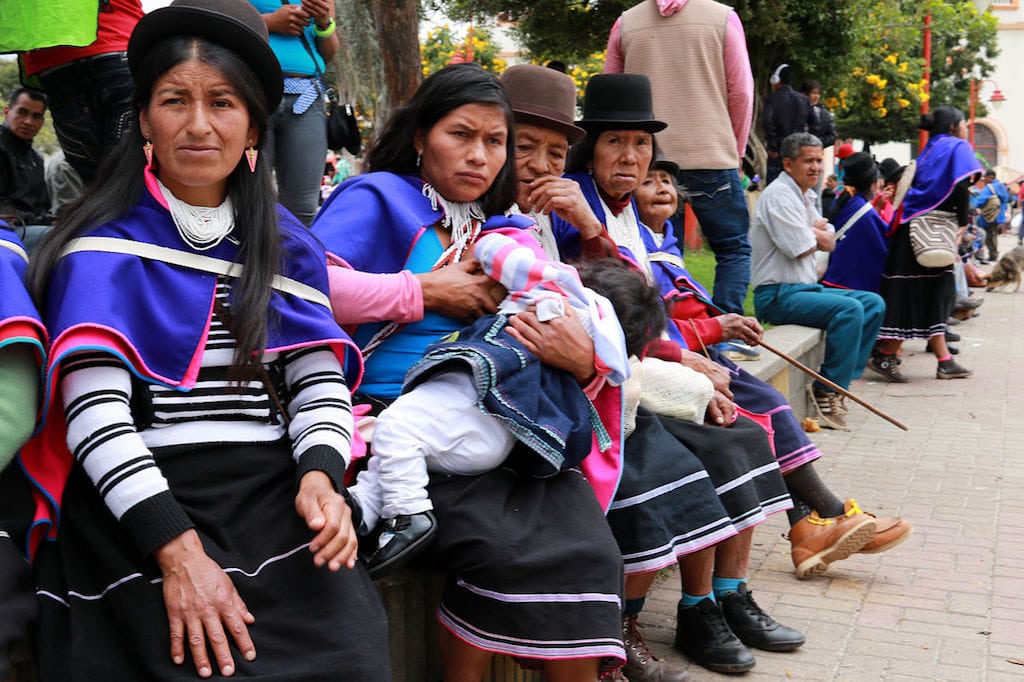
Indigenous Guambiano Indians in Silvia
17. Go to Market Day in Silvia
About two hours from Popayán, the small pueblo of Silvia holds, every Tuesday, a market where the indigenous people of the region, the Guambiano Indians, selling their products.
Every week, the sleepy pueblo wakes up with vendors from nearby villages selling what they’ve grown or made and buying what they need in the very traditional market.
You’ll find sections in the market for a number of products including fruits, vegetables, meats, clothes and shoes. Plus, there are restaurant stalls.
18. Try the Local Gastronomy
In 2005, Popayán was declared the first Gastronomic city in the closed circle of the UNESCO creative cities of gastronomy.
The city enjoys multi-ethnic and multicultural diversity, which is represented in the food available in the neighborhoods in the city.
Typical dishes are the empanadas de pipián, made of potatoes, peanuts and banana leaves; el Carantanta, a fried corn snack; and a rice masato drink to wash it all off!
There is a wide selection of typical Colombian eateries in the city. The town caters to a big student population. So, there are many cheap cafes and local Colombian eateries. But there are also a number of good restaurants in the small city including La Cosecha Parrillada and Il Gallo.
In addition, every year in September, the city holds “The National Gastronomic Congress of Popayán”.
How to Get to Popayán
You can get to Popayán by bus or by plane. Popayán is located in southwestern Colombia between Colombia’s Western and Central mountain ranges.
There are no direct flights to the Guillermo Leon Valencia airport in Popayán from either the José María Córdova Medellín international airport or Olaya Herrera Airport in Medellín. So, if traveling from Medellín, you will have to connect in the El Dorado airport in Bogotá to fly to Popayán.
I took a night bus from Medellín to Popayán. And I paid 92,000 pesos with the company Bolivariano. The journey took about 11 hours from the South Bus Terminal near El Poblado. We previously provided a guide to the Medellín bus terminals.
Also, the San Agustín Archaeological Park is located only 5 to 6 hours by bus from Popayán. So, you could combine a visit to Popayán with a visit to the largest group of pre-Columbian monuments and megalithic statues in South America.
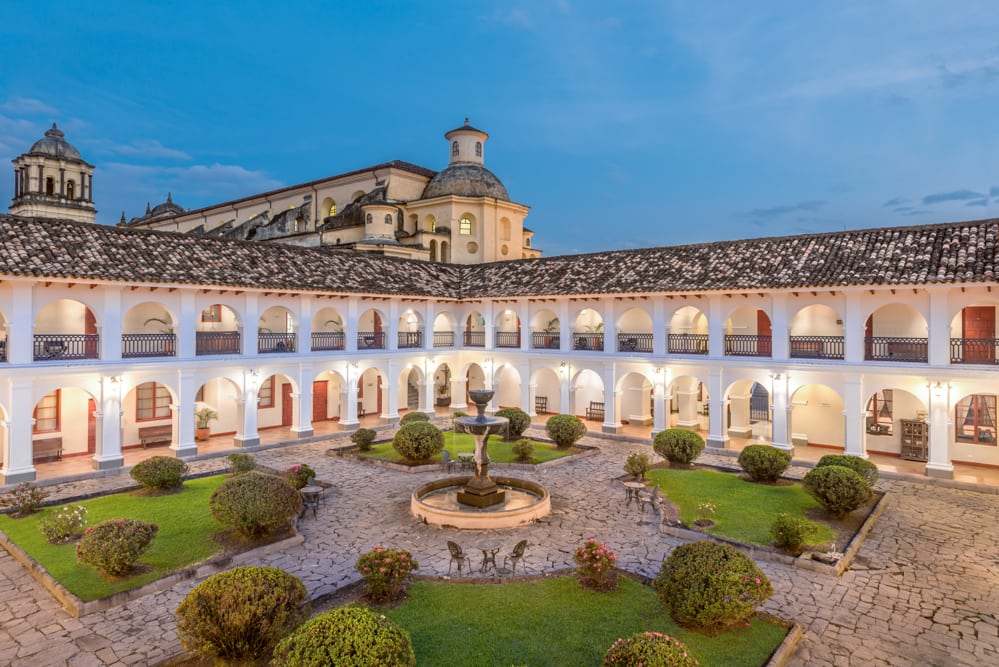
Hotel Dann Monasterio, photo courtesy of Hoteles Dann
Where to Stay in Popayán
There are several different alternatives for hostels/hotels in Popayán for even as little as $6/night depending if you want to stay in the center or not.
ArteHostel and Hostel Caracol are two hostels located in the Colonial center of the city, which have the two highest ratings on Hostelworld.
And two of the most highly rated hotels in Popayán are Hotel La Plazuela and Hotel Dann Monasterio.
Also, there are many furnished apartments in Popayán found on Airbnb with rates from $12 to over $100 per night.
Top Things to See and Do in Colombia
On the Medellin Guru website, we have been looking at some of the most beautiful places in Colombia in a series of top things to see and do in Colombia. This is due to many readers asking about several of these things to do in Colombia.
We have looked at 20 of the top things to see and do in Colombia, in alphabetical order:
- Caño Cristales – the most beautiful river in Colombia, which has also been called the most beautiful river in the world by some people.
- Carnival in Barranquilla – the second largest carnival in the world.
- Cartagena – Oozing history, romance and sun-drenched beaches, the allure of historical Cartagena is hard to resist.
- Ciudad Perdida – the site of an ancient city in Colombia that is older than Machu Picchu in Peru.
- Colombia’s Pacific coast – often overlooked by tourists visiting Colombia but offering untamed nature and undiscovered beauty that is off the beaten path for most foreign tourists.
- Desierto de la Tatacoa – the second largest arid zone in Colombia is Tatacoa Desert, which has surreal desert landscapes and some of the best stargazing in Colombia.
- Guatapé – a picturesque pueblo near Medellín known for its huge rock and lake. And it’s likely the most visited pueblo in Colombia by foreigners.
- La Guajira Peninsula – one of the most visually stunning places in South America, which is located on the northern tip of Colombia where the desert meets the sea.
- Las Lajas Sanctuary – the most beautiful church in Colombia, which has also been called the most beautiful church in the world.
- Medellín’s Christmas lights – Medellín’s annual world-class Christmas lights known as Alumbrados Navideños.
- Medellín’s Feria de Las Flores – Medellín’s world-famous flower festival each year.
- Parque Nacional Natural Los Nevados – a popular national park in Colombia located in the heart of the Colombian coffee region.
- Parque Tayrona – known for its beautiful beaches and the world’s highest coastal mountain range.
- Popayán – a colonial gem in Colombia best known for its white buildings and churches, it’s a city off the beaten path for foreign tourists but is definitely worth visiting.
- Rio Claro Nature Reserve – located about three hours from Medellín, Rio Claro is the perfect place to unplug from hectic daily life and enjoy a picturesque crystal-clear river, canyon and tropical rainforest.
- Salento and the Cocora Valley – Salento is a picturesque pueblo in Colombia’s coffee region and the nearby Cocora Valley is one of the most striking landscapes found in Colombia.
- San Agustín Archaeological Park – the largest group of pre-Columbian monuments and megalithic statues in South America and is a UNESCO World Heritage Site.
- San Andrés – Colombia’s Caribbean island which is a UNESCO World Biosphere Reserve featuring many beaches, islets and coral reefs that are filled with flora and fauna.
- San Gil – Colombia’s adventure capital that is full of things to do including white water rafting, paragliding, caving, rappelling, hiking and much more.
- San Jose del Guaviare – a hidden gem and eco-tourism location off the beaten path and offering wildlife watching, jungle trekking and delving into Colombia’s prehistoric past.
Also, we included Popayán in our list of the top 20 tourist attractions in Colombia.

Popayán at night, photo by Car710
The Bottom Line: Popayán is Worth Visiting
Popayán has a colonial architecture matching Cartagena’s, a history rivaling the history of Bogotá or Medellín, a religious presence as prestigious as Jericó. All those ingredients make Popayán a unique and admiring place to visit.
I particularly appreciated the concentration of things to see and do in the small city compared to the much larger cities of Medellín or Bogotá where everything is more spread out with traffic to contend with. Popayàn’s population is just above 250,000 people.
So, I could walk peacefully with my camera around my neck, totally immersing myself with the surroundings and taking many photos.
I highly recommend adding Popayán to your travels in Colombia. It’s a lesser known city in Colombia with a vibrant history and beautiful Colonial architecture.
Sign up for the Free Medellin Guru Newsletter – You can see all of the previous Medellin Guru weekly email newsletters and sign up here.

